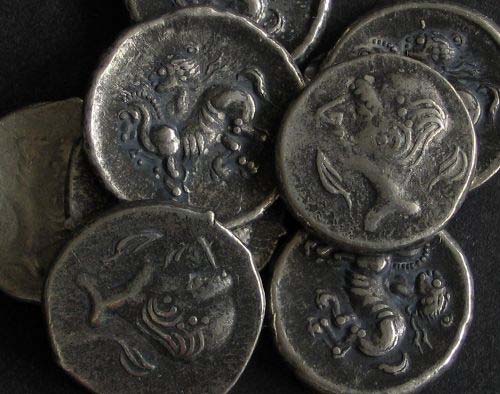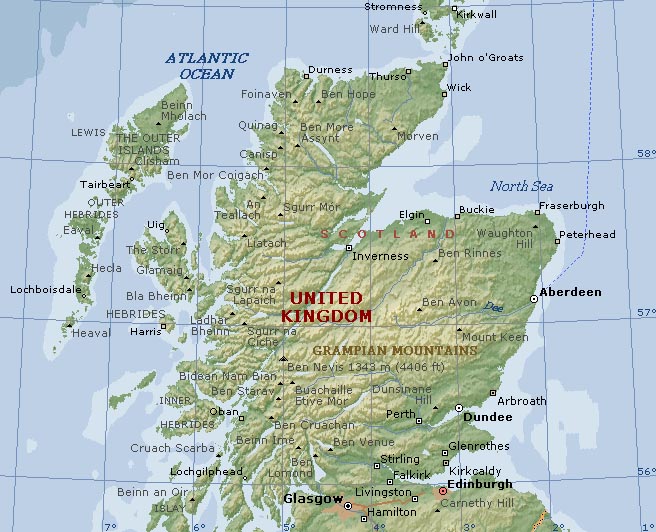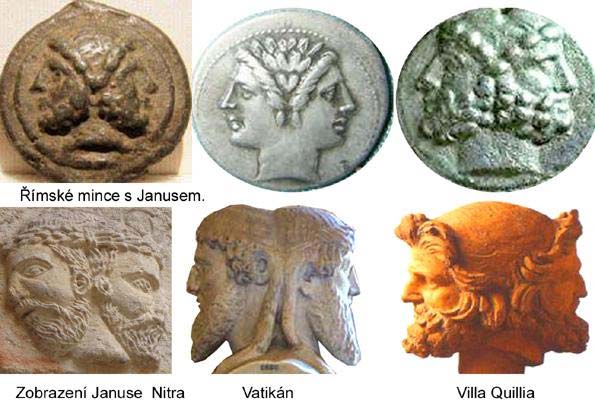Poučný, obsáhlý a nádherně sepsaný článek, bravo sousede! 
Celts, Rome and Scotland
Categories: Castles, strongholds and extinct places
In what is now Scotland, long before the birth of Christ, there were Celtic tribes, of whom we know almost nothing, yet we see references to their culture and traditions at every turn. The Roman conquerors called this territory Caledonia and it has gone down in history as such.
Celtic tribes settled the area of what is now Scotland in several waves. The first of these, which can be described as Proto-Celtic, arrived in Caledonia sometime during the 13th century BC, and has been identified by archaeological finds as the Ashfield culture. This culture settled in the Lowlands of Scotland, from where it expanded northwards into the Highlands. The second of the great waves of migration took place at the dawn of the Iron Age, probably between 800 and 700 BC, and these newly arrived people were already true Celts. At this point I would like to dwell on the word "Celt" and its origin.
Since the Celts themselves left no written monuments, (we are referred to the accounts of Greek and Roman authors who, from 6. We can only refer to Roman and Roman authors who began to come into contact with the Celtic ethnic group in the sixth century BC.

We first encounter the term "Celt" in the 6th and 5th centuries BC. The Greeks refer to "Keltoi", the Romans later use the term "Galli" or "Celtae", and Diodorus of Sicily, Caesar or Pausanias state that all designations are of the same meaning. Moreover, Diodorus and Caesar both agree that the Celts themselves referred to themselves as "Celtae". This clearly shows that the designation "Celts" is original and therefore of Celtic origin. As for the specific meaning of the word "Keltoi - Celtae - Celts", it is thought to be basedfrom the word "hidden", which in Irish can be attested by the word "ceilt" meaning "secret" or "secret" According to this theory, "the word Keltoi means hidden or secret people, referring to the Celtic religious practice of recording their extensive knowledge in writing.
One of the earliest written accounts of the Caledonian Celts was left to us by the Greek traveller and merchant from Massalia, Pytheas, who undertook an expedition sometime during the second half of the 4th century BC, an adventurous journey north along the shores of Western Europe to find a new suitable connection for the trade in northern amber.
Up to the time of Roman expansion, then, we are dependent on material sources, obtained mainly from archaeological excavations, to understand the life of the Celts from the north. In many ways they resembled the mainland Celts, but they did have their own peculiarities, for example in the area of settlements and buildings. Apart from small homesteads, consisting of a few cottages and classical settlements or forts protected by a palisade, there are isolated buildings in Scotland that are not found elsewhere. These are the so-called brochs /fon. "These are the so-called 'brochs', circular tower-like structures made of dry-stacked stones, which had both a settlement and fortification function. There are five hundred of these throughout Scotland, of which fifty are well preserved, but they are particularly concentrated in the north of the country and on the islands of Orkney and Shetland, where the best preserved broch is on the Isle of Mousa.
The largest of these structures reached heights of up to 15 m, were about 10 m in diameter and their walls were 3-4 m thick. This was because the walls contained living quarters, usually two storeys high, and there was a gallery for the defenders on top. Archaeologists have determined the age of these structures to be about 2200 years.
The ancient inhabitants of Scotland are known throughout the world as Picts, which comes from the Lat. "Picti" and probably means as much as "Painted People". The Picts were so designated by the Romans, who began to penetrate Caledonia from the 1st century AD, during the reign of the Emperor Vespasian. We will come to that, however. According to the existing knowledge, the tribes that we call Picts are considered to be a slightly different Celtic people who spoke the so-called P-Celtic, a language that separated from the mainland Celtic milieu and later became extinct. The second group of Celtic languages is the so-called Q-Celtic, which evolved into the present-day Scottish Gaelic or Irish. Local names, especially in Central and Northern Scotland, refer to the ancient Celtic language.
The Picts themselves were called Priteni, and it is interesting to note here that in Welsh texts the people are referred to as Pretani. Yet the word Pretani was used by ancient writers to refer to the inhabitants of the Pretan Islands, which were nothing other than British islands. As is becoming apparent, the Latin name for the islanders, Brittones, evolved from the corruption of the Pretans.
If I am to mention the social structure, it cannot but be said that it was essentially the same as the social stratification in Gaul.

Each of the less than twenty tribes in Caledonia had its own aristocracy, recruited mainly from the ranks of warriors - this status quo persisted until the Middle Ages, when theand the priests, the druids, were a separate, highest social class. In later times, as can be understood from Roman writings, in the event of a threat to freedom, a high king was chosen from among all the tribal kings to lead the defence of the country.
"The 'best' documented period of Scottish antiquity is undoubtedly the Roman period, when attempts were made to annex Caledonia by force to the Empire. As I have already mentioned, the first attempts to penetrate northwards were made during the reign of the Emperor Vespasian of the Flavian family, or the governorship of Gnaeus Julius Agricola in Britain. Agricola served as governor of the island country from AD 77-84, during which time he had considerable military success in the Caledonian expeditions. During his reign over Britain, he put down a rebellion in what is now Wales, circumnavigated the whole of Britain, provingproving that he was an island, and advanced with his legions as far into Caledonia as present-day Aberdeenshire in the north-east of Scotland.
In 80 AD he reached the River Tay with an army of 20,000 men and the following year built a chain of twenty forts between the Forth and Clyde bays. Beyond this imaginary dividing line lay the "wild" Caledonia, whose inhabitants, thethe Manx wrote of as a savage and barbaric people, fighting naked and painted, knowing no culture. But the opposite was true. The Picts were of a very high cultural level and some of the finds of their metalwork or jewellery made of precious metals are among the finest in Celtic art. Also notable are the so called. The Pictish stones, which are artfully decorated stone stelae, with depictions of various decorative, often intricate designs, very realistic images of animals, and rarely depictions of humans. The claim that the Picts fought completely naked seems equally dubious. It is true that Celtic warriors were known to fight as God created them, with only weapons and a neckcloth, but this was not an act of unculturedness but for religious and ritual reasons. These warriors were called Gaesatians, and some ancient authors confused them with a separate tribe. It is therefore possible that these Gaesatians also appeared in the ranks of the Picts, but given the climate in Scotland, the presence of an entire army is almost impossible.
In 82 AD Agricola returns to the south of Scotland to put down a revolt by the Novantes, but the very next year he marches north again, accompanied by legions. Throughout the journey, the soldiers had to face attacks from the Picts, who understandably did not want their freedom given away for free. This was one of the reasons why the Romans spread rumours about the Picts, like "they are savages wilder than animals" etc. The reality was that they didn't want to submit to the so called pax Romana - the Roman peace, which was always beneficial for only one side. But at the same time they avoided direct contact in battle, as they were aware that such a machine as the Roman army was hard to stop let alone defeat.
But a decisive battle did take place. It was probably in 83 or 84 AD when the Romans reached the very north of what is now Aberdeenshire, the place Tacitus refers to as Mons Graupius. Here 30,000 Caledonians led by Chief Calgacus clashed with Agricola's legions. Calgacos and his companions attempted to raid the rear of the Romans and thus break through their ranks, but unfortunately they were surrounded by Roman cavalry, which caused a massacre in their ranks. Meanwhile, while the Roman losses were negligible - only 360 men - Calgacos lost 10,000 warriors in the battle. But this did not prevent the guerrilla war from continuing. One reason for the heavy losses was the impractical Celtic armament, consisting of a long heavy sword and a smallcircular shield, which were ineffective against the small sharp swords and large shields of the legionnaires.

Shortly after the defeat of the Picts, when Agricola was planning the complete sack of the Highlands and the invasion of Ireland, he was recalled from Britain by the Emperor Domitian and transferred with one legion to the Danube, where unrest began to occur. In 87 there was a complete evacuation from Caledonia as the situation became untenable for the Romans and so they had to withdraw. Roman forts were abandoned before they were completed - a typical example is the Pinnata Castro camp at Inchtuthill for 5,000 men. Sallustius Lucullus was installed as governor, but his abilities fell far short of Agricola's.
Another turning point in the history of the conflicts between Rome and the Caledonians was in 122, when the Emperor Hadrianus gave instructions to secure the northern frontier. Approximately between the present-day towns of Carlisle and Newcastle upon Tyne, a massive wall was built across the country - Hadrian's Wall. Construction began under the governorship of Platorius Nepos, who deployed the II, VI and XX Legions, who spent six years building the wall. But the result was grandiose. From bay to bay, a total of 117 km, the wall, including the gallery, stretched 6.5 m high, with a thickness of 3 m, and a 9 m wide trench was dug in front of the wall itself. At every Roman mile /1.6 km/ there was a fortress, and between each fortress there was a small guard fort halfway with a garrison of 500 men. There were 20,000 legionaries from all corners of the empire serving on the entire fortification. This construction really helped to secure the frontier for a time and, above all, to protect Roman territory from small raiding parties from the north.
Less than twenty years later, in 140 AD, the Romans managed to move the border further north and so proceeded to further secure it. This time it was between the Forth and Clyde bays, and since the emperor was Antoninus Pius, the rampart bore his name by analogy. This defensive wall took two years to build and was not nearly as monumental as Hadrian's. It was 59 km long, using less stone and more earthen ramparts secured by wooden palisades.and the original six large fortresses were gradually supplemented by small ones, each a mile long. Construction was carried out under the supervision of the governor of Quinta Lollia Urbica.
However, the construction of the Antonine Wall did not have the expected effect. already in 154 it was conquered by the Caledonians and the Romans were pushed behind Hadrian's Wall. After some time they returned again, but were again driven out, and so the frontier was finally stabilized in 196 at Hadrian's Wall. Everything beyond it was free and lost to Rome forever.
The last one who could muster any major military action beyond the limit was the emperor Septimius Severus, who between 208 and 210, penetrated, like Agricola, deep into the heart of Caledonia, but fought no battles there and was soon forced to make peace with the Caledonians and withdraw back behind the wall.
During the 4th century, tribes of Irish Celts, called Scots, began to flow into Caledonia and gradually took control of the west coast. In 367 they allied with the Picts and together they then headed south. They conquered Hadrian's Wall, invaded England where they destroyed many Roman settlements and fortresses and even sacked London. They then returned to Scotland with their spoils, where they were safe - but they would probably not have been in any serious danger south of Hadrian's Wall. The Roman Empire was in increasing trouble and the whole situation was badly out of control. It all came to a head in 410 when all the troops from Britain were withdrawn, leaving Hadrian's Wall abandoned.
Two powerful kingdoms gradually crystallised in the free territory of Caledonia, Dalriada of Scotland and Pentland or Pictland of Pictland. These two countries eventually united under one king, Kenneth I, in 844. MacAlpine, who then led them into battle against the new invaders, the Germanic Saxons, Danes and Norsemen. But that's another chapter of history...
Bobanx + internet
You can search for artefacts from this period using our metal detectors.
The article is included in categories:
Post
Poučný článek a dobře sepsaný.
Ten clanek nema chybu,klobouk dolu.
je to pekný článok!je to jeden z mojích snov nájsť aspoň jednu keltskú mincu v živote...
je to pekný článok!je to jeden z mojích snov nájsť aspoň jednu keltskú mincu v živote...
zde si popřečítejte to samé, co tu, akorát aspoň nápis změnil
http://antika.avonet.cz/article.php?ID=5176











